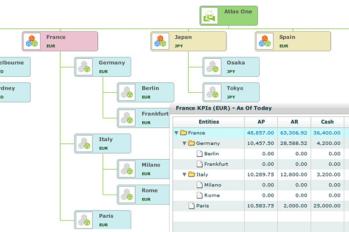Intacct wins converts with help of its channel

One facet that's becoming a distinctive, default feature for SaaS financials apps is real-time drill-down into consolidated global operational finance data — such as, who are my ten biggest debtors worldwide, or what's the dollar value of my sales pipeline in Southern Europe this week? With yesterday's announcement of Intacct's latest release, I've now seen this from all three of the big-name pureplay SaaS financials vendors [disclosure: Intacct is a current client]. NetSuite brought this capability live last year with its One World edition, and it has always been one of the core attributes of Workday's proposition. Like Workday, Intacct has coupled this with a new Flex-based user interface (see partial screenshot below).

With conventional software, this kind of capability is only available at huge additional expense, but it comes standard with SaaS. That's a tremendous competitive advantage for SaaS vendors aiming to win over midmarket customers. As I wrote last spring of NetSuite's OneWorld offering:
"Business decision-makers in today’s highly connected world feel a pressing need to have access to accurate, real-time data when they make decisions, and conventional midmarket business software doesn’t give them that, especially if they operate internationally or across multiple business units ... [E]ach separate business operation has its own business systems and the data from each system has to laboriously aggregated at the end of each month before it can be evaluated. This time lag is going to be even more keenly felt now that everyone is nervous about the effects of the credit crunch. If your sales have suddenly reversed the rising trend of the past few years, you need to know that straight away, not six weeks after the fact."
More than a thousand of Intacct's 3,000 or so customers use its multi-entity and multi-currency capabilities (in fact, if it wanted to play a numbers game, it could claim "more than 10,000 businesses" in its customer base, taking into account separate entities within these customers). All of them will now be able to take advantage of the global consolidation function, which allows users to drill down from the global view to any individual record or transaction, and permits instant reporting and analysis of virtually any permutation of real-time data.
Thanks to this kind of capability — together with a longstanding strength in core financials and reporting — Intacct is now starting to win over its first Oracle Financials converts. The savings such customers can realize are pretty impressive — even though that's a clear signal these companies should probably should never have been sold the Oracle package in the first place. "The full subscription cost of Intacct for these companies is between a half and three-quarters of just the maintenance price for Oracle," Druker told me. As in many such cases, that means the customer effectively can Switch to SaaS for free.
At the other end of the scale, Intacct is also aggressively looking to pick up more Intuit QuickBooks converts. The friendlier user interface is one aspect of this, but Intacct is letting the money do most of the talking. It has cut its entry-level price in half to $400 per month per company, and has worked with partners to establish a fixed-price migration service that starts at $2000, which is anything from two-thirds to four-fifths less than what partners were charging before.
Druker also attributed partners the credit for Intacct's Oracle successes and noted that 50 percent of the company's new business came via the channel this past year. This is further evidence that the SaaS channel is thriving, where providers have the right strategy. The final element in the Intacct story is its MAX ecosystem of certified SaaS solutions that integrate with the financials package. To some extent such linkages are a necessity for a best-of-breed player that doesn't offer other applications (yesterday it announced a new partnership with professional services automation vendor QuickArrow). But it also dovetails well with the channel development strategy, as one of the big opportunities for partners is to be the first point-of-call for customers who want to implement integrated business processes across multiple SaaS applications.
One final sign that SaaS financials have arrived is the willingness of mainstream computer magazines to review them alongside conventional software packages. PC Magazine has just published a review of Intacct's fall 08 edition (one of the perils of print publishing of course is that your reviews of on-demand applications are always one edition behind), recommending it as a good midrange accounting product for those migrating from QuickBooks. Now wonder, as fellow Enteprise Irregular Vinnie Mirchandani noted, Druker's presentation finished with a slide entitled Life is Good.